These short essays were written to accompany specific images on the eventual textbook website. The images have been chosen from sources that should be relatively permissive with their copyrights. The hope is that, with the co-operation of the image holders, we may post high-resolution versions that future students can zoom in on and examine in detail while they read. Focusing on two sources--the John Carter Brown Library’s Archive of Early American Images and the University of Virginia’s Visual Record of the Atlantic Slave Trade and Life in the Americas--he image analysis team found 1,282 images pertaining to Brazil. From these, the team narrowed down the pool to 59 images that most effectively tied in with broader historical themes. The team chose to write analyses on twelve of these images, and believe it would be worthwhile to include some or all of the other 47 images on the website without commentary.
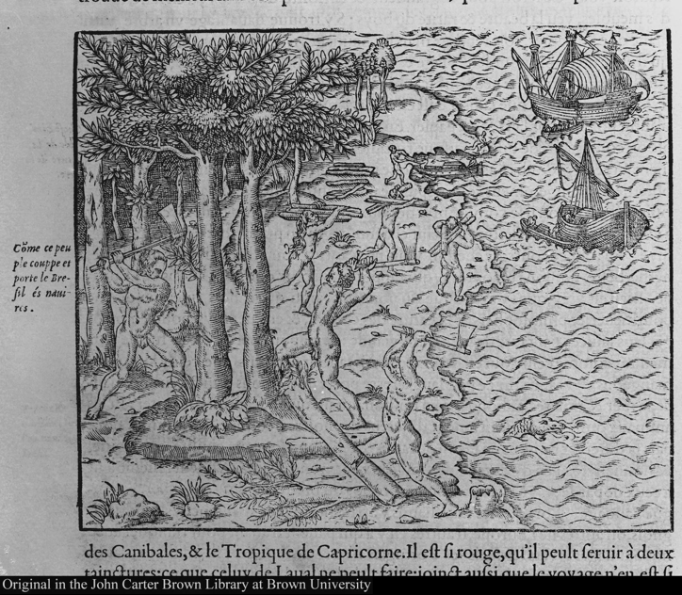
“How the people cut and bring the Bresil to the ships” - André Thevet, 1575 ©John Carter Brown Library, Archive of Early American Images ID: 980014 In this illustration, native Brazilians chop down trees and tote them to nearby European ships. The artist, André Thevet, was French, as was the book in which this image first appeared, so it is likely that Thevet was depicting one of France’s attempts to trade along the Brazilian coast, which lasted from 1504 to 1615. When the picture was published in 1575, its caption acknowledged the contentiousness of the French presence, noting that Portugal had claimed a significant stretch of untapped Brazilian coastline as its own. This claim purportedly stretched from the Tropic of Capricorn (which intersects with South America on the Atlantic side in the present-day state of Sao Paulo) north to the “promontory of the Cannibals.” Brown University’s John Carter Brown library suggests this alluded-to promontory may have been near the present-day Guianas; if that assumption is correct, then the Portuguese crown was claiming over 3,000 miles of coastline. Earlier in their overseas expeditions, such a broad swath of land would not have mattered much to Portuguese interests, because settlement was not in the small country’s equation. It was only in the mid -1500s that the old style of erecting trading posts (feitorias) and exchanging goods with the locals fell out of favor. Imposing political control had been a goal far subordinate to that of building a vibrant trade network, which the Portuguese did admirably. However, declining returns from trade posts in the Indian Ocean, combined with competition from the French and Spanish, forced the crown’s hand towards settled colonization as a means of ensuring future revenue. Given the amount of activity being afforded to this timber, it’s safe to conclude that the Indians are chopping down pau-brasil, or brazilwood, the region’s first cash crop. “Pau” means “wood” in Portuguese, and “brasil” comes from the word “brasa,” meaning “ember.” Pau-brasil could be processed into a fine red dye prized by elites because red connoted power. Previously, dyes came from the east, often from China, but now Portugal had a direct line to a lucrative export that could be sold to European weavers. At this point, Brazil was still a vast unknown. In art, the curvaceous naked bodies of indigenous women reflected its fertile allure; here, we see not only naked bodies, but also a narwhal peeking its head out of the waters in the lower right. The unicorn-like sea creature suggests that there is something mythically mysterious about this new world, an uncharted place potentially overflowing with tropical riches that were waiting to be taken.
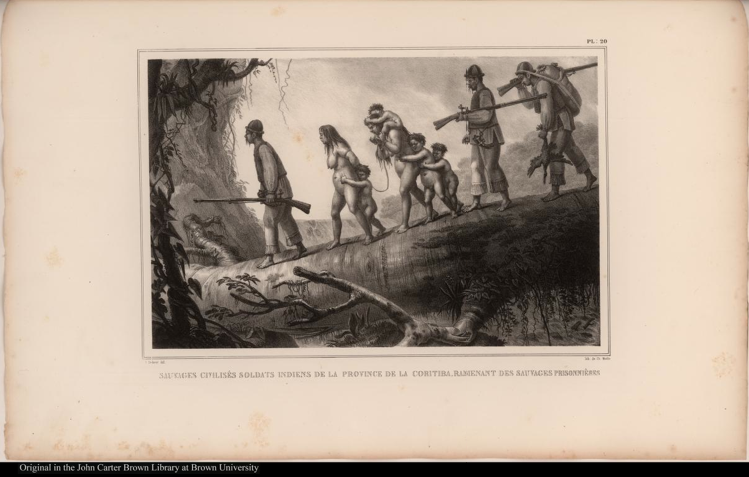
“Civilized Indian Soldiers of the Province of Cortiba Bringing the Saved” - Jean Baptiste Debret, 1834
©John Carter Brown Library, Archive of Early American Images ID: 8770004
One of the many myths endemic to Brazilian society is that of the bandeirante—a swashbuckling native of São Paulo who charged into the untamed wilderness in search of precious minerals and Indian slaves. In modern popular imagery, these cowboy-esque heroes are often depicted as white Europeans, but in reality they were often of mixed racial background. In this Jean Baptiste Debret lithograph, indigenous peoples who have been “civilized” by European forces aid in the capture and transport of fellow natives through the wilderness towards populated areas where they would surely become slaves. This disturbing event is not a fluke – many bandeiras (the name given to the westward expeditions of the bandeirantes) included indigenes who saw the slave-hunting missions as less demeaning than agricultural work. Indeed, a 1629 bandeira included 69 whites, 900 mamelucos (mixed-race peoples), and 2,000 Native Brazilians.
A caption accompanying one print of this Debret painting says the dead-eyed soldiers followed the rivers to find their next victims. After finding an inhabited village, they would reportedly kill all the native men and take the remaining women and children prisoner. By the time of the lithograph’s publication, in 1834, Indian slavery is thought to have ended, but it did persist in some regions well into the era of African slavery. Despite the vulnerability of Indian populations to European diseases, these slaves were cheaper than Africans, and the whites of diverse backgrounds who participated in the bandeiras were entitled to reap some of the spoils—that is, they received gratis Indian slaves as payment for their efforts. By the late 1700s, however, bandeiras came to focus on land conquest rather than labor acquisition. The Indians of Debret’s time who still had their original lands were thought to be too resistant for productive slave labor.
The
mixing of races as it related to slavery can also be seen in “Capture of a
Runaway Slave,” an 1826 engraving by Alcide Dessalines d'Orbigny (Image
reference NW0317a, as shown on www.slaveryimages.org,
sponsored by the Virginia Foundation for the Humanities and the University of
Virginia Library; http://tinyurl.com/UVAbandeirante).
In this picture we see a “bush captain” – likely a bandeirante – of dark
complexion escorting a recaptured slave back to his master. The prisoner and
the bandeirante look quite similar, as was the case with the Debret painting,
but it’s clear their roles in Brazilian life could not be more different.
Gilberto Freyre, author of The Masters and the Slaves, describes the bush captain seen here as
half-Portuguese, half-mulatto, but without the stark visual cues of their
attire and means transportation, it would be easy to get these two men mixed
up.
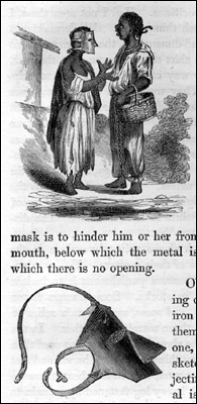 | 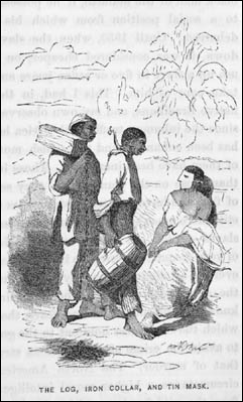 |
“Metal Face Mask” and “Punishments for Runaways” - Thomas Ewbank, 1856, and Daniel P. Kidder, 1857, respectively
Image references ewbank3 and kidder6, as shown on www.slaveryimages.org, sponsored by the Virginia Foundation for the Humanities and the University of Virginia Library
It is tempting to conflate the brutality of slavery with the American attitudes towards race that encouraged violence in the United States. In the U.S., the one-drop rule meant that any slave blood made you a slave; the understanding of race was (and is) more complicated in Brazil. Despite the lack of stigmatized miscegenation (interracial sexual relations), cruelty still ran rampant among slaveholders. In the first image, from Life in Brazil by Thomas Ewbank, a woman in a metal mask attempts to converse with a man wearing a collar and chain. In the second image, another slave, possibly a woman, wears a very similar “tin mask” and talks with two slaves; one of them has a log chained to his neck, while the other wears a metal collar.
Ewbank says the metal mask is a “preventative of drunkenness…the mask is to hinder him or her from conveying liquor to the mouth,” while Kidder says the mask is used on “country-slaves” to keep them from eating dirt, “to which many of the field-negroes are addicted.” Ewbank does not assign any special purpose to the punishment of his masked slave’s companion, but Kidder says the unmasked slaves in his print are failed runaways. Although he did not draw and publish sketches of them, Ewbank also describes, in the course of the same account, even crueler devices of punishment: “shackles for binding the ankles and wrists close together, and consequently doubling the bodies of the victims into the most painful and unnatural positions.” In the northern provinces, he also cited cases of slaves who would be hoisted off the ground and beaten “as near to death as possible.” It would be rash and inaccurate to say that slavery was more benign in Brazil than in the United States; however, a link to more recent social turmoil has made the punishments doled out to Brazilian slaves unique.
Some of the same techniques used on disobedient slaves were later employed in the 20th century during the interrogations of political dissidents. Torturers working on behalf of the military regime, which ruled from 1964 to 1985, would force a prisoner into what is known as the “parrot’s perch.” Sitting in a contorted fetal position, the victim would have a metal rod inserted between their arms and knees. The military interrogators would then apply electric shocks in an effort to extract information, but the first part of the process comes directly from a typical slave punishment, as depicted in a famous painting by Debret. In “Plantation Overseers Punishing Blacks” (Image reference NW0207, as shown on www.slaveryimages.org, sponsored by the Virginia Foundation for the Humanities and the University of Virginia Library; http://tinyurl.com/UVAwhipping), a slave in the foreground is crumpled in pain, likely naked, around the parrot’s perch as a master or overseer whips him. Today in Recife (the capital of the northeastern state of Pernambuco), one can see a monument to the victims of the parrot’s perch (photo licensed under Creative Commons Attribution 2.0 Generic License, taken by Flickr.com user marcusrg; http://tinyurl.com/CCparrotsperch). This minimalist monument, unveiled in 1993 by the human rights group Tortura Nunca Mas, frames a single political prisoner suspended in the air from the perch against the backdrop of Recife’s skyline.
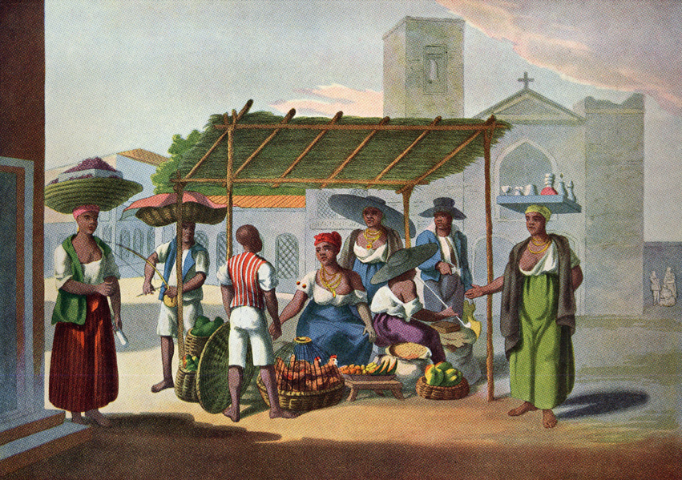
"Market Stall and Market Women, Rio de Janeiro" - Henry Chamberlain, 1822
Image reference vista04, as shown on www.slaveryimages.org, sponsored by the Virginia Foundation for the Humanities and the University of Virginia Library
Here we see a depiction of market life in 19th-century Rio de Janeiro, a scene conspicuously devoid of non-African faces. Black freedwomen run the market stall in the center, but the labor status of the other figures in the picture is not entirely clear. A master living near an urban center like Rio might send a slave to town to buy, sell or trade goods in exchange for a small cut of the eventual profits. Through the course of tasks like this, some servants were even able to buy their freedom, as may have been the case with the central women here. Notice the jewelry adorning three of the women; perhaps they are wealthy enough to have bought both their freedom and expensive jewelry? Not necessarily, no—in Brazil, there were other paths to freedom besides purchasing your own life away from your master.
After the Jesuits successfully lobbied for an end to the Indian slave trade, African slaves were brought over in vast quantities. By 1823, some 1.16 million slaves had been imported; even after the African trade was “ended” in 1826, traders brought in an additional 712,000 human chattel through the 1940s. This abundance led to a freer practice of manumission (the freeing of slaves) than in other countries. Whereas an American slaveholder might work his human property through till death, a wealthy Brazilian might conclude that it was cheaper to shop from the seemingly limitless supply of new, young slaves rather than continue to feed and house an aging one.
Finally, take note of the actions in which Chamberlain has captured his painted subjects. The market woman on the far right, carrying wine and rum, and the woman on the far left, carrying milho (Indian corn), are doing so with their goods on their heads, a method thought to be imported and preserved from African customs. Likewise, the man standing closest to the milho woman is plucking a madimba lungungo, which Chamberlain described as “an African musical instrument in the shape of a bow, with a wire instead of a string.” These examples reflect the vitality of African culture in Brazilian cities. From music to commerce to the martial-arts dance capoeira (Image reference NW0171, as shown on www.slaveryimages.org, sponsored by the Virginia Foundation for the Humanities and the University of Virginia Library; http://tinyurl.com/UVAcapoeira), customs from across the Atlantic were fluidly integrated into the socially mobile society.
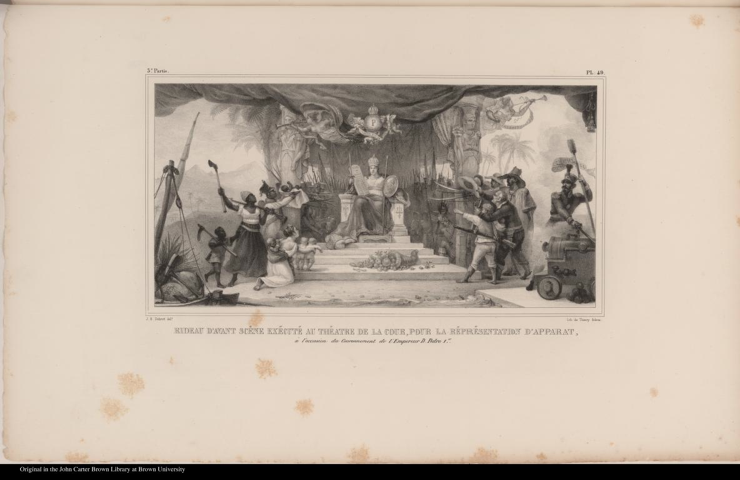
"At the Coronation of the Emperor Don Pedro 1st" - Jean Baptiste Debret, 1839
©John Carter Brown Library, Archive of Early American Images ID: 9170003
Here Debret presents a grand, theatrical interpretation of the ascendancy of Emperor Pedro I and the separation of Brazil from the kingdom of Portugal. Framed by a curtain and flanked by symbols of the new nation’s independence, the former prince regent takes center stage. Debret is at once conveying two messages that later artists would frequently reiterate: that Brazil is a separate entity with its own history; and that, despite its differences with the Old World, its peoples can see it as a peer of the long-standing civilizations that came before it.
The decision to label the new government an “empire” rather than a “kingdom” is a calculated and political one—Roman emperors were divinely supported, but did not receive their earthly power from their blood, as Pedro would have in Lisbon following the death of his father, Joao VI. In theory, at least, a Roman emperor received a mandate from the people to rule on their behalf; lacking an imperial history of its own, Brazil adapted another’s. As Pedro holds the new Constitution, the diverse peoples around him cheer and clamor for his rule. White and black parents put their children forward, as if waiting for them to be blessed, while bandeirantes pledge their allegiance and a soldier fires a cannon in celebration. Notice, in the shadows to the left and right of the throne, the Indian civilians and warriors, respectively; the presence of indigenous peoples was an oft-invoked piece of evidence for “Brazilian history.” In 1862, to commemorate the 40th anniversary of the coronation Debret acclaims here, elites in Rio de Janeiro unveiled an equestrian statue of Pedro I; Native Brazilians are carved beneath the triumphal national monument as a means of reminding viewers that the country had a past before the Portuguese.
Some other details worth observing: the boat in the far left foreground is carrying coffee and sugar, the two most important crops at the time of this painting; the old man on the right is from Sao Paulo, while his grandson, upon whom he is resting, is from Minas Gerais; finally, the entire scene is consecrated by heraldic angels and three cherubim carrying a crowned orb with the letter “P,” presumably for “Pedro.” This orb resembles the imperial coat of arms, which also decorated the national flag until the empire’s end in 1889.
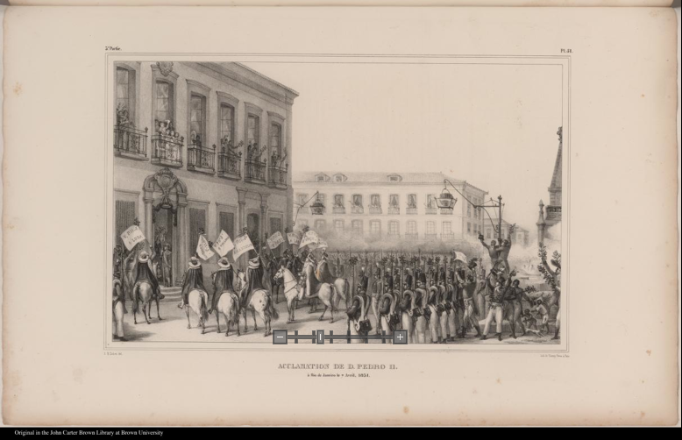
"Acclamation of D. Pedro II in Rio de Janeiro, April 7, 1831" - Jean Baptiste Debret, 1839
©John Carter Brown Library, Archive of Early American Images ID: 9180001
It isn’t easy to see without zooming in, but the focal point of this Debret painting is standing on a chair. In 1831, under pressure from the Brazilian military and the Portuguese monarchy, Dom Pedro I returned to Portugal to assume the throne (his father had died five years prior). In so doing, he left his son Pedro II as the claimant to the Brazilian imperial seat of power. However, Pedro II was five years old at the time, so a triumvirate of regents arranged, planning to rule the country until the young emperor reached age 18. Here we see the symbolic acclamation of the new leader, who waves to the crowd from a balcony in the upper-left while in military dress. For the Brazilian elites, the continued existence of an emperor was vital from a symbolic point of view. Although liberals and conservatives split on how power should be centralized in this still-young government, they supported the regents’ plan all the same.
The men on horseback closest to Pedro’s balcony represent the different sectors of Rio de Janeiro, the capital city from 1793 to 1960. Behind the line of soldiers in the center, notice the celebrating men, many of whom are holding branches, which were meant to symbolize the national colors, green and gold. All the revelers appear to be well off, if not elite. There are no clearly poor people in this audience, but they were not as invested in preserving the status quo as the elites who wanted to ward off any potential political tumult that might accompany a change of power. Indeed, following a series of small revolts in the 1830s that questioned the empire’s legitimacy and what Brazil stood for, the country’s elites pushed for Pedro II to assume power four years early. He did so in 1840, and would rule the “Second Empire” for the next 59 years.